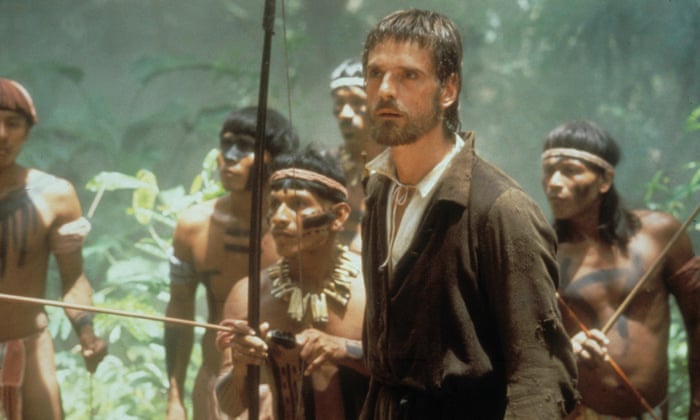Ennio Morricone: a composer with a thrilling ability to hit the emotional jugular
Ennio Morricone: a look back at a creative career spanning 500 film scores – video
by Peter Bradshaw
With his brilliant, haunting scores for Sergio Leone, Quentin Tarantino and dozens more, Morricone was the master of film music
The film industry has its elite squad of composers who can produce a complete orchestral score at the request of a director – and if necessary conduct it too – intuiting almost by magic what is needed and doing this with miraculous fluency and speed. These are composers who are sometimes trusted simply to compose the music without sight of any screenplay draft, composers whose work really is the screenplay, and around whose music the film is partly shaped in the edit suite. There are great names like Hans Zimmer, Alexandre Desplat, John Williams, Mica Levi and Lesley Barber.
But the great ancestor of the modern film music is the Italian master Ennio Morricone, who created a staggering 500 scores over a passionate and inexhaustibly creative career spanning 50 years – working with directors such as Gillo Pontecorvo, Terrence Malick, Roland Joffé, Brian De Palma, Giuseppe Tornatore, Barry Levinson, Quentin Tarantino and of course, Sergio Leone, with whose epic, mythic westerns he will be forever associated – although he would often sharply remind interviewers that these constituted just a fraction of his output. It was a surprise that his first Oscar for best original score only came in 2016 when he was 88 (11 years after he was presented with his honorary Oscar, the point at which film grandees are assumed to have gone into retirement). This was for Tarantino’s The Hateful Eight. It was a glorious achievement, as his score for that movie was so striking and catchy.
The great film composers arguably work on three levels: at bottom, their music provides a kind of deep texture to a film, something felt, not consciously heard by the audience; at a higher level, their composition works in counterpoint to a scene, sometimes working with and sometimes against the ostensible mood; and at the level above that there are the hummable tunes that break the surface of the score. Morricone could naturally do all of them. His most famous work foregrounded unconventional instruments like harmonicas, whistles and cowbells, he created inspirational melodic voices and so he was often closer to what might be called a songwriter.
Leone’s A Fistful of Dollars in 1964, featuring Clint Eastwood’s legendary gunfighter, gave us one of Morricone’s most haunting scores, with its plaintive and slightly nasal mariachi trumpets that declaimed a robust Aranjuez pastiche. The main theme had its ghostly and desolate whip-poor-will whistling cries, whipcracks, bells, eerie percussive shouts. Morricone brilliantly created the mood, the style, the rhetoric of the film, just with the music.
Two years later, Morricone worked on Gillo Pontecorvo’s The Battle of Algiers, and established his own authority, but also his creative diplomacy. He rejected Pontecorvo’s own musical ideas, and in the course of their subsequent rather strained discussion about the score, Morricone found himself listening to a weird little tune Pontecorvo was humming. He turned that into the “Theme of Ali”, the arrestingly subtle, delicate four-note motif performed on a flute that is heard when the insurgent Ali is arrested. Pontecorvo loved the theme, and Morricone didn’t tell him where it came from, but tactfully consented to a musical co-credit for the director.
A very different musical score was his work on Joffé’s The Mission in 1986, and one of his biggest popular smashes: the main theme, Gabriel’s Oboe, denoting Jeremy Irons’s 18th-century Jesuit priest Father Gabriel attempting to use his oboe to beguile the indigenous tribes and convert them to Christianity. The theme itself – for oboe, of course – is very much not inspired by 18th-century music (maybe closer to Tchaikovsky?) but certainly an overwhelmingly seductive and rich melody, with that shrewdly measured spoonful of sugar that Morricone knew how to add.

Jeremy Irons in The Mission. Photograph: Moviestore/Rex/Shutterstock
His music for Cinema Paradiso in 1988, composed with his son Andrea, gives full rein to a swirlingly emotional Italianate extravagance. The main themes are for piano, strings and saxophone and they are there to carry the wistful ideas of melancholy and nostalgia. For me personally, this sweet trolley is a little bit overburdened, but it was a devastatingly effective musical accompaniment and this sad, unashamedly sentimental picture wouldn’t have half the impact without the inspirational supercharge of poignancy in the score.
Morricone’s colossal output was redoubled by the fact that it was always being re-used in movies and TV, a vivid open resource of musical emotion. Tarantino (a devoted fan) reused many of his potent 70s themes in his Inglourious Basterds and got from him a fantastic original song for his Django Unchained – Ancora Qui – sung by its lyricist Elisa Toffoli, hauntingly desolate over a strumming guitar. For me, Morricone’s song here is a great example of his wonderful gift for melodrama in music, a thrilling musical ability to go straight for the emotional jugular.
And then, of course, Morricone actually composed a score for Tarantino, and gave us his late masterpiece, L’Ultima Diligenza Per Red Rock (or Last Stage to Red Rock) , the opening theme from Tarantino’s The Hateful Eight, a seven-minute suite with crashing brass and confrontationally piercing and aggressive string themes that absorbed theme-variations from his previous scores from John Carpenter’s The Thing. It is disturbing, harsh and jagged with the nightmarish “human shout” motif that fans remembered from his spaghetti western work, and yet weirdly hummable. Morricone was an extraordinary creative force in cinema.